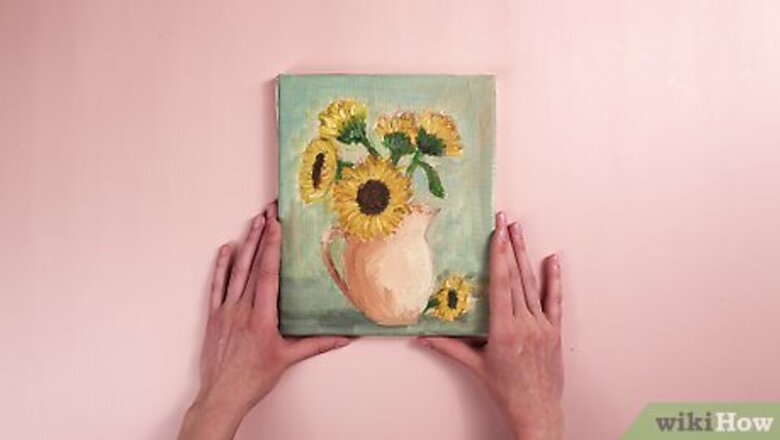
views
Cleaning an Oil Painting on Canvas
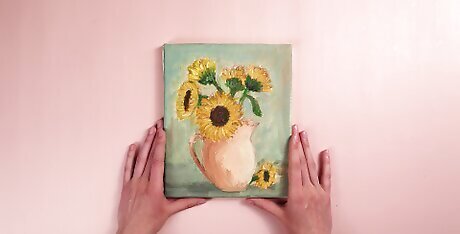
Place the oil painting on a stable surface. If the painting is stable where it's already hanging on the wall, you can leave it in place to clean it. However, it’s usually recommended that the painting be taken down and placed on a flat, stable table or propped up against a sturdy easel for the best results. Removing the painting from the wall also allows you to look at the painting in different lighting conditions and get a better view of the dirt on the surface.
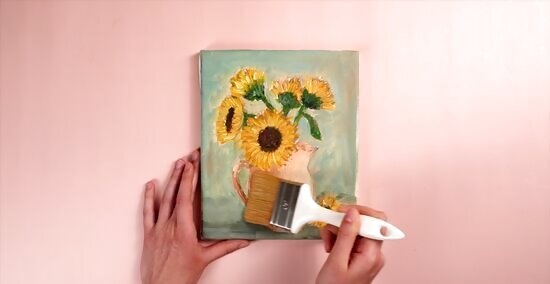
Use a soft white cloth or very soft brush to clean dust from the painting. Take your dry cloth or soft-bristle paint brush and gently swish it against the painting. Start at one of the top corners and work your way down to ensure the dust is removed rather than just moved around. Be extra gentle on areas where the paint has a raised texture. Brushing too hard on those areas can cause the textured paint to break off. Use a cotton bud to clean out any corners that have pockets of dirt stuck in them. Sable bristle paint brushes are known for their softness and considered to be safe for this procedure. Avoid using anything abrasive, like a coarse cloth, paper towel, or feather duster.
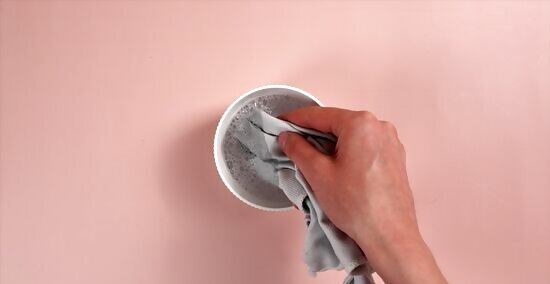
Use a soft cloth and olive oil-based soapy water to remove dirt. Slightly dampen your cloth with a mixture of warm water and olive oil-based soap. Gently blot your oil painting with a damp cloth to take off any residual grime. If there’s still grime left, seek the help of a professional art restorer. Stronger art cleaning products contain chemicals that could ruin your painting if you use them incorrectly. Some museum curators and other professionals use a saliva-coated cotton swab for this step, as the enzymes in saliva can gently break down dirt and grime. If you do try using the spit method to clean your oil painting, test your swab on a small section of your painting and make sure no paint color shows up on the swab.
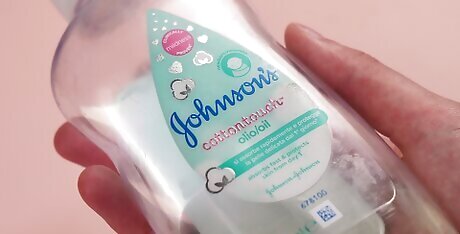
Avoid water, rubbing alcohol, baby oil, harsh soaps, and food products. Using water can change the appearance of the oil paint on the canvas, and rubbing alcohol can remove the paint completely. Some people think that baby oil can return suppleness to the surface of an oil painting and make the colors look brighter, but baby oil actually makes the surface sticky and even more susceptible to attracting dirt. Similarly, avoid popular soap products like Murphy’s Oil Soap and Dawn Dish Soap. These products are great for cleaning oil painting off something, so they shouldn’t be used if you want to preserve your painting. But you can use Murphy’s Soap and Dawn dish soap to clean oil paint off of paint brushes! Some amateurs will tell you that wiping the surface of an oil painting with a slice of doughy bread or a cut potato is a great way to remove dirt and grime from the surface. However, food-based cleaning techniques can leave behind crumbs and residue that will further damage your painting.
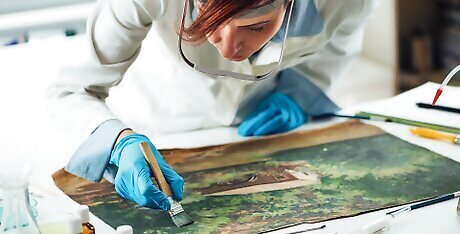
Take valuable or antique oil paintings to a professional conservator. The surface of an oil painting is fragile, and it can be permanently changed or damaged by trying to clean the canvas at home. If your oil painting is old, worth money, or holds great sentimental value, cleaning it at home is not recommended. Take it to a professional conservator to have it cleaned. Get valuable paintings insured before allowing a professional to clean them.
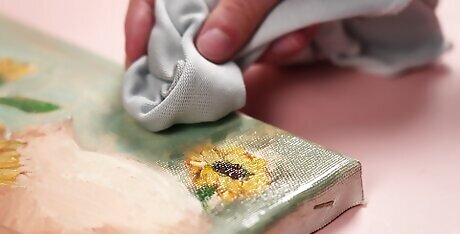
Take oil paintings to a professional conservator to remove varnish. Varnish is a clear protective layer on the surface of an oil painting. Unless you’ve been trained or have experience with removing varnish, don’t attempt it. An oil painting can be permanently damaged if this is done improperly, affecting both the aesthetic and monetary value of the painting. If you decide to attempt this yourself, use a professional cleaning kit made for removing varnish from an oil painting.
Cleaning an Oil Painting on Paper
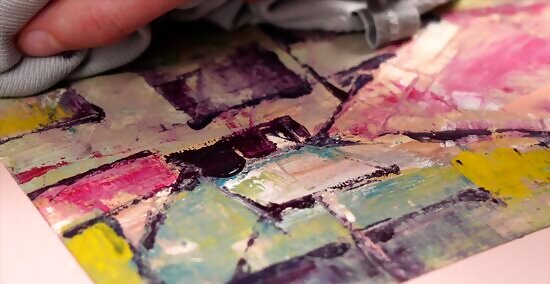
If only oil paint was used, use a cloth and soapy water. If you know that only oil-based paints were used (and no water-based paints), dampen a soft cloth with warm water and olive oil-based soap. Gently dab the cloth onto your painting to break down the dirt. Avoid cleaning any area where the paper is exposed. Getting the paper wet could create a water stain or cause it to change shape. Most paper art pieces are protected by a frame, so you usually only need to clean the glass part of the frame!
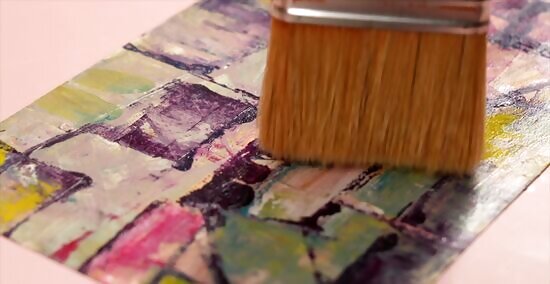
Clean with a soft brush if water-based paints may have been used. If you’re not absolutely sure that only oil-based paints were used in your painting, it’s safer to use a soft, dry paintbrush to clean your piece. Choose a soft-bristle paint brush and gently dust the surface of your painting
Taking Care of Oil Paintings
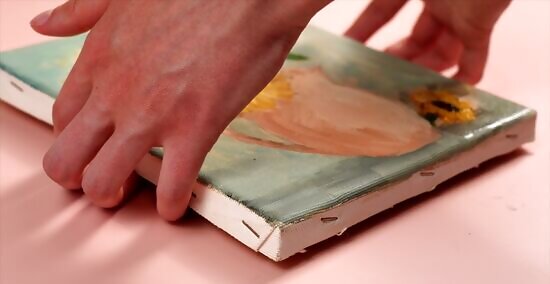
Handling Hold two sides of your painting whenever you lift it so it doesn’t tip and knock against something. Be especially wary of door handles, as they can easily tear through canvas. If you’re wearing any buckles, rings, or sharp-edged objects, remove them before moving your painting. Only lean your painting against flat surfaces rather than furniture or large objects. Handling oil paintings carefully is crucial, as they can dent or tear with very little force. Avoid anything that could tear, put pressure on, or stretch the surface of the canvas.
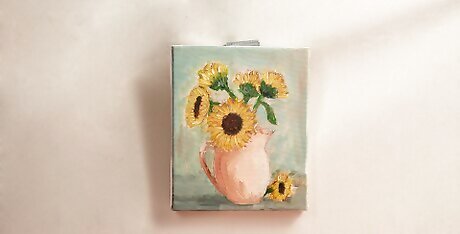
Light Keep your oil painting out of direct sunlight. Hang the painting in a windowless room or on a wall that doesn’t receive direct sunlight. Use lower-wattage bulbs for your artificial lighting and put as much space as possible between the light and the painting. Exposure to direct and indirect light can damage oil paintings and cause the pigments to fade or turn yellow. When it’s not in use, store your painting in a dark room or cover it with a soft piece of fabric.

Humidity Hang your oil painting in a room with low relative humidity, meaning that the humidity level is as stable as possible. The recommended humidity level for an oil painting is between 40% and 60%. Higher humidity levels can lead to mold growth on the painting’s surface. Avoid hanging your painting in the bathroom or any other sources of moisture. If your room is overly humid, use a dehumidifier to remove some of the moisture from the room.
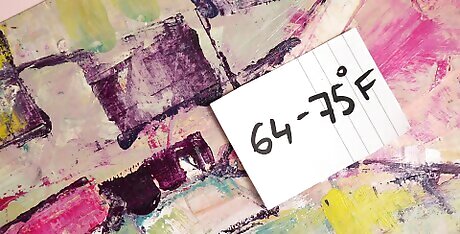
Temperature Keep your painting in a room that stays between 18–24 °C (64–75 °F). Avoid hanging your paintings near any heat sources, including infrared lighting, fireplaces, radiators, and boilers. Intense heat or extreme temperature fluctuations can cause the painting to dry out, crack, or become brittle.



















Comments
0 comment